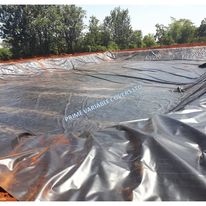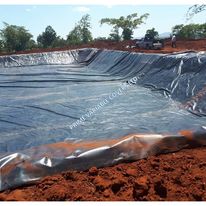For Kenya to effectively manage its water supplies, particularly in areas with little rainfall, dam liners are necessary. We shall examine the advantages and applications of dam liners in Kenya in this blog post.
The Advantages of Dam Liners
Reduces Water Loss: By keeping water from leaking through the ground, dam liners help to conserve water and make more accessible for home consumption, irrigation, and other uses.
Reduces Soil Erosion: By preventing water from running over the surface of the dam, dam liners aid in the reduction of soil erosion. This facilitates crop growth by preserving the soil’s structure and halting the loss of nutrients.
Cost-Effective: Installing a dam liner rather than building a concrete dam is a more affordable approach to store water. Dam liners are less expensive since they are simpler to construct and require less upkeep. Boosts Water Storage Capacity: Dam liners enable dams to store more water in a less amount of space by increasing their storage capacity. This is especially crucial in places where there isn’t enough room to build big dams.
Environmentally Friendly: Since dam liners don’t involve the use of chemicals or other hazardous materials, they are an environmentally friendly choice for storing water. Decreased need on Rain: Farmers can now irrigate crops all year round thanks to dam liners, which lessen their need on rainfall.
UV Resistant: UV-stabilized polyethene, which has a high water retention capacity and is leak-proof, is used to make dam liners. They come in two colours: blue and black.
Simple to Install: Underwater sealants or big sheets that are factory-fabricated can be used to assemble dam liners. It is simple to install them where you want them.
Recyclable: Temporary constructions like dam liners can be recycled or put to new use.
Costly Drawbacks of Dam Liners in Kenya
Using dam liners during the construction of a dam might be costly. The machinery needed for excavation and installation, as well as the dam liner itself, are often expensive.
Expertise Needed: Using dam liners to build a sturdy dam calls for specialised knowledge.
Applications for Dam Liners

Irrigation: Since dam liners help to keep water from evaporating and guarantee that water is accessible when needed for crops, irrigation uses them extensively.
Aquaculture: Ponds are made for fish farming using dam liners. The liners guarantee that the water is of a constant quality and stop it from penetrating into the ground.
Residential Water Supply: Water for drinking, cooking, and washing can be stored in dam liners.
Industrial Water Supply: Industries like mining and manufacturing, which need a lot of water to run their operations, use dam liners.
Climate change has led to erratic weather patterns, making water scarcity a global problem.
Reduce water use and combat global warming.
one such technique is the installation of dam liners, which stop fluid loss through seepage.
The general procedures for installing a dam liner are as follows:
Site Preparation: Select a dam-suitable location and remove any weeds and trash from the area. The location must to have high soil stability and be level.
Choose a liner that is appropriate for the dam that you have. The size of the dam, the velocity of water flow, and the state of the soil will all affect the type of liner. Polypropylene, EPDM, PVC, and polyethylene are common materials used for liner applications.
Installing the liner: Start by laying it down across the dam’s prepared surface. After cutting the liner to meet the dam’s size, any required seams should be welded together.
Originally posted 2024-02-16 15:18:38.

